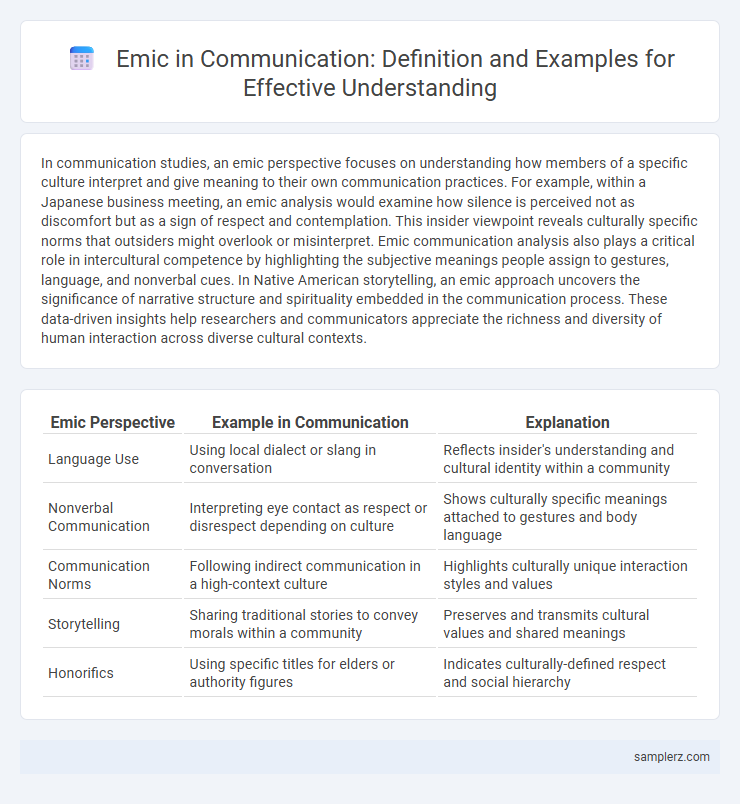In communication studies, an emic perspective focuses on understanding how members of a specific culture interpret and give meaning to their own communication practices. For example, within a Japanese business meeting, an emic analysis would examine how silence is perceived not as discomfort but as a sign of respect and contemplation. This insider viewpoint reveals culturally specific norms that outsiders might overlook or misinterpret. Emic communication analysis also plays a critical role in intercultural competence by highlighting the subjective meanings people assign to gestures, language, and nonverbal cues. In Native American storytelling, an emic approach uncovers the significance of narrative structure and spirituality embedded in the communication process. These data-driven insights help researchers and communicators appreciate the richness and diversity of human interaction across diverse cultural contexts.
Table of Comparison
| Emic Perspective | Example in Communication | Explanation |
|---|---|---|
| Language Use | Using local dialect or slang in conversation | Reflects insider's understanding and cultural identity within a community |
| Nonverbal Communication | Interpreting eye contact as respect or disrespect depending on culture | Shows culturally specific meanings attached to gestures and body language |
| Communication Norms | Following indirect communication in a high-context culture | Highlights culturally unique interaction styles and values |
| Storytelling | Sharing traditional stories to convey morals within a community | Preserves and transmits cultural values and shared meanings |
| Honorifics | Using specific titles for elders or authority figures | Indicates culturally-defined respect and social hierarchy |
Understanding Emic Perspectives in Communication
Understanding emic perspectives in communication involves analyzing the insider's viewpoint within a specific cultural or social group, focusing on their unique language, symbols, and meanings that shape interaction. This approach enhances effective communication by appreciating culturally-specific nuances and avoiding misinterpretations that arise from an outsider's perspective. Researchers and communicators utilize emic insights to develop messages and strategies that resonate authentically with the target audience's worldview.
The Role of Emic Analysis in Cross-Cultural Dialogue
Emic analysis in cross-cultural communication emphasizes understanding behaviors and meanings from the insider's perspective, revealing cultural nuances that external observations might miss. This approach enables communicators to interpret symbolic gestures, language use, and social norms within the cultural context, fostering deeper empathy and avoiding misinterpretations. Employing emic perspectives enhances dialogue effectiveness by aligning communication strategies with cultural values intrinsic to participants.
Everyday Examples of Emic Communication
Everyday examples of emic communication include using local slang or dialect specific to a community, which conveys meanings understood only by insiders. Cultural gestures, such as bowing in Japan or cheek kissing in parts of Latin America, exemplify emic communication practices that reflect shared cultural norms. Storytelling traditions within families or communities also serve as emic communication, embedding values and experiences unique to that group.
Emic Insights: Language Use Within Cultural Groups
Emic insights in communication emphasize how language use varies within cultural groups, revealing unique expressions, idioms, and conversational norms. For instance, understanding the specific metaphors and speech patterns used by Native American communities provides profound cultural meaning that outsiders might overlook. These linguistic nuances enable more authentic intercultural dialogue and foster deeper empathy within diverse social interactions.
Nonverbal Communication: Emic vs. Etic Interpretations
Nonverbal communication illustrates emic perspectives through culturally specific gestures like the "thumbs-up," which signifies approval in Western cultures but may be offensive in others. Emic interpretations prioritize understanding meanings rooted in cultural context, such as the different use of eye contact in Asian versus Western societies. Ethnographic studies reveal how emic views decode body language within cultural norms, essential for effective intercultural communication.
Emic Perspectives in Interpersonal Relationships
Emic perspectives in interpersonal relationships emphasize understanding communication patterns from the insider's cultural viewpoint, capturing the unique meanings and values attributed by individuals within their social context. For example, in collectivist cultures, expressions of respect and family loyalty are communicated through indirect language and nonverbal cues, reflecting shared cultural norms that outsiders might overlook. This insider approach allows for more effective and empathetic communication by recognizing the subjective experiences and culturally specific codes embedded in interactions.
Storytelling Traditions as Emic Communication
Storytelling traditions serve as a prime example of emic communication by reflecting the unique cultural values, beliefs, and social norms of a community. These narratives are transmitted orally within groups, preserving indigenous knowledge and reinforcing identity through culturally specific symbols and language. Emic storytelling enables deeper understanding of a culture's worldview, fostering authentic connections in intercultural communication.
Emic Approaches to Conflict Resolution
Emic approaches to conflict resolution emphasize understanding conflicts from the insider's cultural perspective, prioritizing native communication styles and values. This method involves active listening to local narratives and employing culturally specific conflict norms, such as consensus-building in Indigenous communities or restorative justice practices in Maori traditions. By leveraging emic insights, conflict resolution becomes more effective and respectful of the community's social dynamics.
The Importance of Emic Understanding in Business Communication
Emic understanding in business communication involves grasping the insider's perspective, which enhances negotiation strategies by aligning messages with cultural norms and values. Recognizing emic viewpoints fosters trust and reduces misunderstandings in multinational teams, leading to more effective collaboration and decision-making. Companies leveraging emic insights often see improved employee engagement and customer satisfaction due to culturally resonant communication practices.
Emic Communication Patterns in Digital Communities
Emic communication patterns in digital communities emphasize insider language, norms, and culturally specific expressions that shape interaction within the group. These patterns include unique slang, shared symbols, and context-dependent meanings understood only by community members. Recognizing emic communication enhances the authenticity and cohesion of online social networks by fostering a sense of belonging and identity.

example of emic in communication Infographic
 samplerz.com
samplerz.com